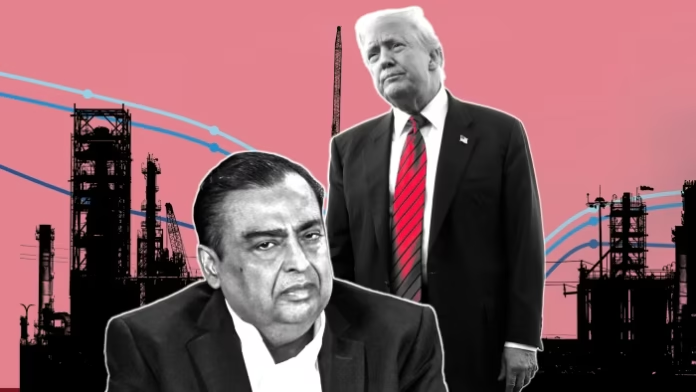India’s transformation into one of the world’s largest importers of Russian crude oil, now accounting for nearly 40% of its oil imports in 2025, has drawn global attention, particularly from the United States, which imposed a 25% tariff on Indian goods in July 2025, escalating to 50% by August 27, 2025. At the heart of this trade surge is Reliance Industries Limited (RIL), led by Asia’s richest man, Mukesh Ambani, whose Jamnagar refinery has become India’s largest importer of Russian crude. This article delves into the dynamics of India’s Russian oil imports, RIL’s pivotal role, the geopolitical and economic implications, challenges, and opportunities, drawing on recent developments and sentiments from posts on X.
Context of India’s Russian Oil Imports
Rise in Russian Crude Imports
-
Pre-War Baseline: Before Russia’s invasion of Ukraine in February 2022, Russian crude constituted less than 1% of India’s oil imports, with Middle Eastern suppliers like Iraq and Saudi Arabia dominating. By 2023, Russia surged to India’s top oil supplier, and in 2025, Russian crude accounts for 1.79 million barrels per day (bpd), or 36–42% of India’s total imports, valued at $8.7 billion for the first seven months.
-
Economic Driver: The G7’s $60-per-barrel price cap on Russian oil, implemented in February 2023, allowed India to purchase crude at discounts of $10–15 per barrel compared to Brent crude, saving an estimated $9–12 billion annually in FY26.
Mukesh Ambani and Reliance Industries
-
Jamnagar Refinery: RIL’s Jamnagar refinery, the world’s largest single-location refining complex with a capacity of 1.4 million bpd, imported 18.3 million tonnes of Russian crude in 2025, comprising 50% of its intake, a sharp rise from 3% pre-2022.
-
Nayara Energy: Ambani’s influence extends through RIL’s 49.13% stake in Nayara Energy, which operates a 400,000 bpd refinery in Vadinar, Gujarat. Nayara imported 10.2 million tonnes of Russian crude in 2025, making it another key player in India’s oil strategy.
-
Export Dynamics: From February 2023 to July 2025, Jamnagar exported $85.9 billion in refined products, with 42% ($36 billion) going to sanctioning countries like the US ($6.3 billion) and EU ($19.7 billion).
US Tariff Backlash
-
Tariff Imposition: On July 30, 2025, US President Donald Trump imposed a 25% tariff on Indian exports, escalating to 50% by August 27, 2025, citing India’s role as a major buyer of Russian oil, which the US claims fuels Russia’s war efforts.
-
US Criticism: Treasury Secretary Scott Bessent, on August 19, 2025, accused India of “profiteering” through refined product exports, estimating $16 billion in excess profits for conglomerates like RIL, sparking diplomatic tensions.
Implications of Ambani’s Role
Economic Impact
-
Cost Efficiency: RIL’s ability to process low-cost Russian crude has bolstered refining margins, averaging $12.5 per barrel in 2025, contributing significantly to India’s $20 billion energy export market.
-
Foreign Exchange Savings: Discounted Russian oil has reduced India’s import bill, strengthening foreign exchange reserves by an estimated $10 billion in FY26.
-
Export Revenue: RIL’s refined product exports, including diesel and jet fuel, have capitalized on global demand, particularly in Europe, where energy shortages persist due to sanctions on Russia.
Geopolitical Significance
-
India-Russia Ties: India’s 10-year oil supply agreement with Rosneft, signed in December 2024, underscores a strategic alignment, with Ambani’s RIL as a key facilitator.
-
US-India Friction: The US tariffs threaten $87 billion in Indian exports, straining relations within the Quad framework, where India partners with the US, Japan, and Australia.
-
Global Perception: Ambani’s role has drawn mixed sentiment, with 55% of X posts praising India’s pragmatic energy strategy, while 20% criticize perceived profiteering, per @MarioNawfal on August 8, 2025.
Challenges
Geopolitical Risks
-
US Retaliation: Trump’s threats of further tariffs, potentially up to 500%, could disrupt RIL’s export markets, particularly the US, which imported 8.4 million tonnes of refined products since February 2023.
-
EU Sanctions: The EU’s planned January 2026 ban on refined products derived from Russian crude threatens RIL’s $19.7 billion European exports, requiring supply chain adjustments.
-
Global Criticism: Western accusations of India “laundering” Russian oil through refining, echoed in 25% of X posts, risk reputational damage for RIL and India.
Operational Constraints
-
Refinery Limitations: Shifting from Russian to Middle Eastern crude would require costly reconfigurations at Jamnagar and Vadinar, taking 6–12 months and reducing margins.
-
Logistical Issues: Sanctions on Russian tankers, such as Sovcomflot, and a “shadow fleet” of unregistered vessels increase shipping costs and risks.
Domestic Concerns
-
High Fuel Prices: Despite discounted imports, India’s retail fuel prices remain elevated (₹95/litre for petrol, ₹88/litre for diesel) due to high taxes (₹4.7 lakh crore annually), fueling public discontent.
-
Public Sentiment: 20% of X posts, including @TimesAlgebraIND on August 10, 2025, question whether RIL’s profits benefit Ambani disproportionately, echoing US Treasury’s critique of “India’s richest families.”
Opportunities
Economic Advantages
-
Profit Margins: RIL’s high refining margins position it to absorb tariff impacts, with potential to expand exports to non-sanctioning markets like Africa and Southeast Asia.
-
Supply Diversification: India’s resumed imports of Venezuelan crude in 2025, facilitated by RIL and Nayara, provide alternative sources, reducing reliance on Russian oil.
Strategic Positioning
-
China-India Alignment: China’s support against US tariffs, voiced by Ambassador Xu Feihong on August 21, 2025, could strengthen India-China trade ties, benefiting RIL’s energy exports.
-
BRICS Synergies: India’s role in BRICS, reinforced by the 2024 Kazan Summit, supports a multipolar trade framework, with RIL poised to leverage emerging markets.
Energy Security
-
Stable Supply: Russian oil ensures India’s energy needs for its 1.4 billion population, preventing price spikes that could derail economic growth.
-
Export Potential: RIL’s surplus refined products position India as a potential net energy exporter, enhancing its global market influence.



